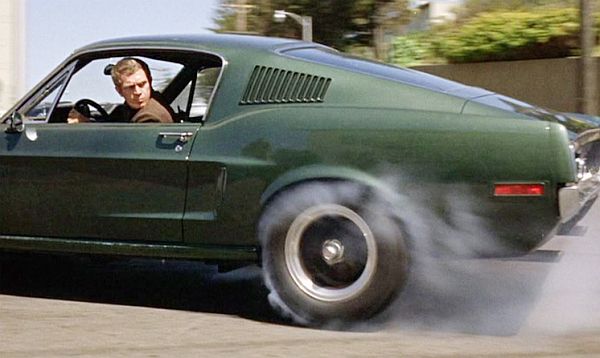Mexicali, Mexico - The legend has been the same for decades: There were two 1968 Ford Mustang GT fastbacks provided by the Blue Oval as stunt cars in 1968's Bullitt, starring Steve McQueen. Both were Highland Green with aftermarket Cragar wheels, equipped with howling S-code 390s and four-speeds - though sometimes a 289 was claimed to be the nimble jump car's motivator - and both were modified by Hollywood car builder Max Balchowsky to fit the interior movie lighting and cameras while also upgrading the chassis and suspension for the those famous jumps through the streets of San Francisco.
After filming, the lesser-damaged Mustang was sold to a Warner Brothers employee named Robert Ross, who sold it to a now-retired New Jersey detective named Frank Marranca (coincidentally, "Frank Bullitt" was McQueen's detective character), who then sold it in 1974 to the anonymous current owner that allegedly hid it in a Kentucky Barn - and the second stunt car, the one that folds the front suspension at the end of the chase scene, was allegedly so heavily damaged during filming that it was crushed.
Despite letters from McQueen attempting to buy what was thought to be the last surviving car from the mysterious third owner in 1977 (before his death in 1980), it was assumed that the story ended there - as heartbreaking of a conclusion as one could imagine for the legacy of both the actor and film.
That is, until a dusty, white '68 fastback was pulled from a backyard in Mexico - ironically to be remodeled into a clone of the "Eleanor" Shelby GT500 from 2000's Gone in 60 Seconds. When the body shop ran the build plates through the Marti Report, an extensive early Mustang background check, things changed.
VIN 8R02S125558, the consecutive build number of the previously lone-surviving Kentucky Bullitt (8R02S125559), had been found. The history books were wrong: the second Bullitt stunt car was indeed sold after filming, though it's currently unknown how.
 |
According to Federico Garza - the Stangs de Mexicali club member who discovered the news when the body shop's owner, Ralph Garcia Jr., came to his fastener shop, hands shaking, with photos of the car and VIN plate. Two Mustangs were purchased by Hugo Sanchez with the intention of using both to build an Eleanor tribute. The car had been around for 20-30 years, at one point abandoned down in the Baja California Sur peninsula, before Hugo finally rescued it.
This, of course, could have been one of the biggest travesties in movie and Mustang history had it not been for Ralph's research, which led to Kevin Marti's early Mustang report. The Marti Report is something you buy when researching that next six-digit auction buy to make sure it's the real deal; and Kevin's word, backed up by a private database of factory Ford records and information, is considered the gospel for a Mustang owner looking for the exact history of their car - and it didn't take long until he found himself at a Ford dealership in Mexicali.
With Ralph's blessing and Stangs de Mexicali's support, Federico arranged for the car to be featured at a local Ford dealership to showcase the discovery. In the months ahead, Ralph's body shop replaced the roof, quarters, and floor pans (though they are staying with the Baja Bullitt) before quicky painting ahead of the unveil. Federico then began posting photos to the Vintage-Mustangs forum, with the membership showing equal amounts of skepticism and mouth-foaming.
Everything came together last Friday, March 3, when Kevin finally met the Baja Bullitt in Mexicali. With a jubilant mariachi band, the Baja Bullitt was pushed inside for Kevin's inspection. It took about a half-hour, but Kevin, Hugo, and Ralph finished their inspection with success and smiles. According to Kevin, the Baja Bullitt was 8R02S125558 - the lost stunt car.
Over the weekend, the Baja Bullitt made its way back to the United States (with Federico's father escorting the convoy to the border), and according to Fox News, it's heading to Ralph's Paramount, California, shop for a restoration with its new owner ahead of the film's 50th anniversary.
Source: Motortrend.com. This article originally appeared on the Hot Rod Network.


